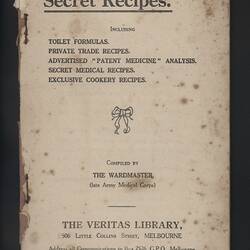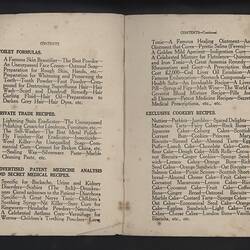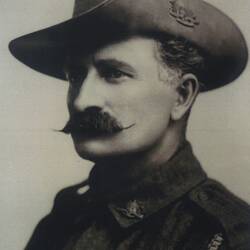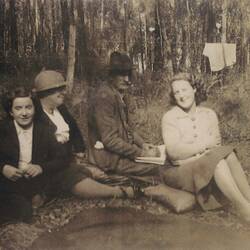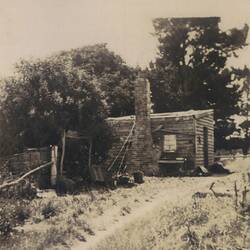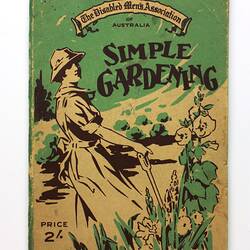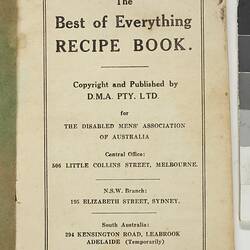Summary
Book entitled 'Secret Recipes: Including Toilet Formulas, Private Trade Recipes, Advertised "Patent Medicine" Analysis, Secret Medical Recipes, Exclusive Cookery Recipes', published around 1923. Compiled by 'The Wardmaster', who is identified by the State Library of Victoria as Thomas J. Holmes. Holmes served in the Royal Army Medical Corps during World War I and apparently migrated to Australia after the war. He became secretary (and possibly founded) the Disabled Servicemen's Association of Australia.
The book contains around 15-30 recipes under each of its headings. They range from benign recipes for cakes and cookies to cures for drunkenness, 'a great nerve tonic' (p.22) containing syrups of phosphates and hyopohosphates and quinine; 'lung tonic' (p.26) containing syrup of tolu and oils of aniseed and cloves; and a stain eradicator. The book has been heavily handled over the years, but only a single mark, a cross against a recipe for Nutties (actually a recipe for Anzac biscuits), suggests a particular recipe was used.
'Secret Recipes' was published by Atlas Press, a Melbourne publishing house. It was part of the 'Veritas Library' series. According to the book, 'The Veritas Library employs Returned Soldiers who, owing to disablements and other causes, are unable to follow their pre-war occupations. Every returned soldier or other salesman who has authority to sell this book, carries a letter of declaration from the Publishers, constituting their authority to sell.'
The book was given to the donor's grandmother by her grandfather, Thomas Llellwyn Thomas, service number 6018, soon after World War I. Thomas L. Thomas was a 'lineman' (possibly later known as a 'linesman') when he enlisted at Melbourne on 24 July 1916. He served in the 21st Battalion. According to the donor he was pictured on a recruiting poster before he went overseas. Thomas was wounded in the nose and arm on the Western Front on 9 October 1917, and on receiving medical treatment it was noted he had been suffering from trench fever for nearly a month. He was repatriated to Australia in February 1918. After the War he divided his time between a shack in Ballarat (where he worked his own gold mine) and his home in Bokhara Road, Caulfield where his family lived. He found gold over the years but spent most of it, including one occasion when he went to Melbourne on a spending spree and came home with only a white satin waistcoat. He also variously worked as a mechanic and postal employee over the years. He died of a seizure on Anzac Day, 1939, at the age of 65.
Physical Description
62-page book with red paper cover. Cover title printed in black with simple motif of black rectangle. Front cover detached and very creased and torn at spine; back cover missing. Pages are yellowed and have rounded corners; foxing throughout. Two rusted staples bind the book.
Significance
This book is typical of many published in the years immediately after World War I, to be sold by disabled soldiers for fund-raising or to assist soldiers and their families in post-war life. The book claims to contain formulas 'costing thousands of pounds', and helpfully suggests how some recipes might be changed if they are to be sold, acknowledging that some former soldiers may need to rely on their own enterprise.
The book was apparently written by Wardmaster T.J. Holmes soon after World War I. According to Dr Richard Travers, Wardmaster T.J. Holmes served in the Royal Army Medical Corps during World War I and came to Australia after the war. He became secretary (and possibly founded) the Disabled Servicemen's Association of Australia. 'His intentions seem to have been to educate the public on health matters, and to provide income for returned servicemen who were not able to work; they were given the books to sell on the street.' (Travers, 2009)
This book and publications provenanced more clearly to the Disabled Men's Association of Australia, also touches on an important but little-discussed aspect of Australian society after World War I: tensions between disabled groups, particularly soldiers and non-soldiers. The Disabled Men's Association of Australia, established in 1925, ostensibly supported disabled men, whatever the cause of their disability. Its patrons included war hero Sir John Monash and Brigadier-General T.A. Blamey as well as civilians. However, some sources claim that the Association refused to support disabled ex-soldiers since they had been given a 'certain glamour' that the incapacitated civilian lacked, and therefore already had an advantage. Disabled civilians were:
'deserving of a fuller sympathy, at least a deeper pity, for their need is as great as that of the bravest soldier. Do they not breathe the same air, buy in the same markets, have the same rents to pay? Many have met with their incapacity since marriage. Have they not homes and children to provide for? Is not theirs a greater need?' (Disabled Men's Association of Australia, 1928)
Complicating matters, disabled ex-soldiers frequently opposed each other as well. A veteran with a 'crook leg' complained against the favouritism shown to the limbless. ('Crook Leg', 1920) Considerable time was spent debating how physically maimed a man had to be to join associations. (Bourke, 1998)
More Information
-
Collecting Areas
Public Life & Institutions, Home & Community, Medicine & Health
-
Acquisition Information
Donation from Kaye Routledge, 18 Sep 2011
-
Organisation Named
Veritas Library, 506 Little Collins St, Melbourne, Australia, circa 1923
The date is identified by the State Library of Victoria's catalogue of an apparently identical publication. The date does not appear on Museum Victoria's copy. -
Publisher
Atlas Press, Melbourne, Victoria, Australia, circa 1923
The publisher is identified by the State Library of Victoria's catalogue of an apparently identical publication. The name does not appear on Museum Victoria's copy. -
Other Association (See Comments)
Disabled Men's Association of Australia Pty Ltd, Australia, 1925
The compiler of the book, apparently Wardmaster Thomas J. Holmes, was involved in and may have established the Disabled Men's Association. -
Inscriptions
Cover: 'SECRET / RECIPES / Compiled by / THE WARDMASTER / (late Army Medical Corps) / Formulas / Costing Thousands of Pounds / 2/- / COPYRIGHT'. Extensive text within book.
-
Classification
-
Category
-
Discipline
-
Type of item
-
Overall Dimensions
124 mm (Width), 8 mm (Depth), 182 mm (Height)
-
References
Bourke, Joanna 1998, 'The Battle of the Limbs: Amputation, Artificial Limbs and the Great War in Australia', Australian Historical Studies, vol 29:110, pp. 49-67 Crook Leg 1920, 'Correspondence. Tweed Industry', Diggers' Gazette, 15 December, p. 49 Disabled Men's Association of Australia 1928, 'Bruised reeds', Disabled Men's Association of Australia, Melbourne Travers, Richard 2009, 'A doctor's delights: discoveries from the Richard Travers collection: an exhibition of material from the Monash University Library Rare Books collection', Monash University Library, Clayton
-
Keywords
Cooking, Disability Organisations, Recipes, World War I, 1914-1918, Home Maintenance, Remedies


